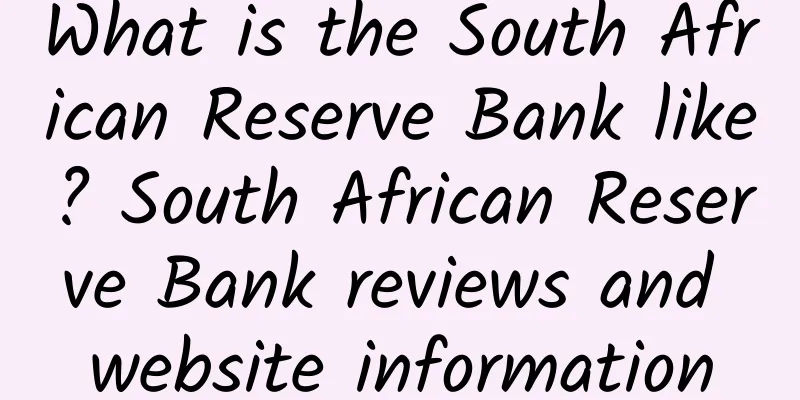What is the South African Reserve Bank like? South African Reserve Bank reviews and website information

|
What is the South African Reserve Bank website? The South African Reserve Bank (SARB) is the central bank of South Africa. It was established in 1920 and is headquartered in Pretoria. It mainly provides South African economic information, monetary and financial policies, financial and price stability, important statistics, systems and supervision, etc. Website: www.resbank.co.za The South African Reserve Bank (SARB) is the central bank of South Africa. It was established in 1920 and is headquartered in Pretoria, the administrative capital of South Africa. As the central bank of South Africa, the South African Reserve Bank plays a vital role in the country's economic and financial system. Its main responsibilities include formulating and implementing monetary policy, maintaining financial stability, managing the country's foreign exchange reserves, issuing currency, and supervising the banking industry. Historical Background of the South African Reserve BankThe establishment of the South African Reserve Bank can be traced back to the early 20th century. At that time, South Africa's financial system was relatively weak and lacked a unified central bank to coordinate and manage the country's monetary and financial policies. In 1920, the South African government decided to establish the South African Reserve Bank to cope with the increasingly complex financial environment and economic challenges. Since its establishment, the South African Reserve Bank has undergone several major changes. In particular, in the late 20th century, as the political and economic environment in South Africa changed dramatically, the role and functions of the South African Reserve Bank also changed accordingly. In 1994, South Africa ended the apartheid system, and the South African Reserve Bank continued to work to maintain the country's financial stability and economic development in the new political and economic environment. The main functions of the South African Reserve BankThe main functions of the South African Reserve Bank include the following:
South African Reserve Bank's organizational structureThe South African Reserve Bank's organizational structure consists of the following main parts:
South African Reserve Bank's Monetary PolicyThe South African Reserve Bank's monetary policy is one of its core functions. The main objectives of monetary policy are to control inflation, promote economic growth and maintain financial stability. The South African Reserve Bank influences the money supply and credit conditions in the market through adjusting interest rates and open market operations, thus having an important impact on economic activities. The monetary policy framework of the South African Reserve Bank is based on inflation targeting. According to this framework, the South African Reserve Bank sets a clear inflation target and controls the inflation rate within the target range by adjusting interest rates and other means. Inflation targeting helps to improve the transparency and predictability of monetary policy and enhance market confidence in monetary policy. The South African Reserve Bank’s monetary policy tools mainly include:
The South African Reserve Bank's financial stability roleThe South African Reserve Bank's financial stability function is another important responsibility. Financial stability refers to the ability of the financial system to operate effectively and resist external shocks and internal risks, thereby providing a stable financial environment for economic growth. The South African Reserve Bank ensures the stable operation of the financial system by regulating the banking industry and financial markets. The South African Reserve Bank's financial stability functions mainly include the following aspects:
South African Reserve Bank's Foreign Exchange Reserve ManagementThe South African Reserve Bank is responsible for managing the country's foreign exchange reserves to ensure South Africa's ability to pay and credibility in the international financial market. The management of foreign exchange reserves is of great significance to maintaining South Africa's monetary stability and responding to external shocks. The South African Reserve Bank's foreign exchange reserve management mainly includes the following aspects:
The South African Reserve Bank's currency issuance functionThe South African Reserve Bank is the only institution with the power to issue currency in South Africa. It is responsible for designing and issuing the South African Rand (ZAR) and ensuring that the circulation and supply of currency meet the needs of the economy. The South African Reserve Bank's currency issuance functions mainly include the following aspects:
Regulatory role of the South African Reserve BankThe South African Reserve Bank is responsible for regulating the banking industry in South Africa and ensuring the sound operation of banks and the stability of the financial system. It formulates and implements regulatory policies and monitors banks' capital adequacy, liquidity management and risk management to prevent financial crises. The regulatory functions of the South African Reserve Bank mainly include the following aspects:
South African Reserve Bank economic information releases |
<<: What is PetrolWatch like? PetrolWatch review and website information
>>: How is HubPages? HubPages review and website information
Recommend
The efficacy and function of wild lemon wine
Wild lemon can be said to be the predecessor of l...
How to eat golden tangerines and the effects of eating golden tangerines
Jinqian tangerine, also known as kumquat, is a tr...
How is Millcype College? Millcype College reviews and website information
What is Millsaps College? Millsaps College is a fa...
The efficacy and function of Lithospermum officinale soaked in olive oil
Lithospermum is a common Chinese medicinal materi...
How to pickle salted duck eggs to make them oily quickly? Tutorial on how to pickle salted duck eggs
Salted duck eggs are a common way for people to e...
How to cook Korean food Korean food recipe tutorial
Korean food is very popular nowadays. Korean rest...
How to peel potatoes quickly Tips on how to peel potatoes quickly
Potatoes, also known as potatoes, are not only ve...
Origin, Growth Environment and Varieties of Hami melon
When I talk about Hami melon, I will think of the...
Tutorial on how to pickle mustard greens
Mustard greens are a green and healthy vegetable....
How to make flower wine? Brewing methods and techniques of flower wine
Flower wine, as the name implies, is a drink made...
What is Piaggio? Piaggio reviews and website information
What is Piaggio? Piaggio & C. spa is an Italia...
How to eat the avocado pit best? Avocado pit eating tips tutorial
Avocado, also known as avocado, is a delicious fr...
The efficacy, function and medicinal value of yew
Many people are very familiar with yew. It is a c...
How to pickle Northeastern pickled cabbage
Do you sometimes feel like you have no appetite w...
What is Mitsubishi Chemical Holdings like? Mitsubishi Chemical Holdings reviews and website information
What is Mitsubishi Chemical Holdings? Mitsubishi C...









